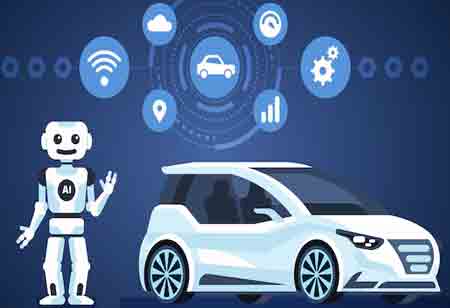THANK YOU FOR SUBSCRIBING
THANK YOU FOR SUBSCRIBING
Be first to read the latest tech news, Industry Leader's Insights, and CIO interviews of medium and large enterprises exclusively from Auto Tech Outlook

By
Auto Tech Outlook | Thursday, January 30, 2025
Stay ahead of the industry with exclusive feature stories on the top companies, expert insights and the latest news delivered straight to your inbox. Subscribe today.
The autonomous vehicle (AV) industry is going through a transformative period as solution providers are racing against each other to address the complexities of self-driving technology. What was a far-fetched dream a few years ago, AVs are today on the cusp of being deployed across the board due to gains in AI, sensor technology, and software integration. Tech behemoths to niche startups across the spectrum are fiercely competing to perfect the systems that would power self-driving cars, trucks, and other forms of mobility.
The industry's defining trend is the shift from standalone development to collaborative ecosystems. Leading AV solution providers increasingly partner with automakers, sensor manufacturers, and cloud service companies to accelerate progress. This collaborative approach allows them to combine machine learning, computer vision, and real-time data processing expertise with traditional automotive players' manufacturing scale and experience. This trend is reflected in partnerships, which indicate that shared innovation is the only way to overcome technical and regulatory hurdles.
Sensor technology and AI algorithms are driving rapid development in the technology behind autonomous vehicles. Advanced lidar, radar, and camera systems provide high-fidelity environmental perception for safe navigation. Companies are refining sensors to increase accuracy, reliability, and low cost. At the same time, solution providers have been using breakthroughs in AI to enhance object detection, trajectory prediction, and decision-making systems. The increased use of perception systems based on neural networks has been made possible by powerful computing platforms from NVIDIA.
Regulatory challenges remain a significant barrier, but there has been progress in creating frameworks to guide AV deployment. Countries like the United States, Germany, and China actively work on policies to ensure safety while promoting innovation. The introduction of autonomous driving laws, such as California's AV permit program and Germany's Level 4 vehicle regulations, highlights the delicate balance between fostering technological development and protecting public safety.
The public acceptance component weighs heavily in the industry. Surveys show mixed sentiment, with safety concerns being a significant hurdle besides trust in the technology. Solution providers focus on transparency, public demonstrations, and real-world testing to overcome this. Companies offer ride-hailing services in select cities, allowing users to experience autonomous technology firsthand. These initiatives aim to build trust while gathering valuable operational data to refine their systems further.
The competition among AV solution providers is intense, with each company pursuing a unique approach. Few in the field focus on developing a fully integrated software and hardware stack, and servicing under robotaxi form underpins their efforts toward Level 4 autonomy. On the other hand, many companies have stressed urban mobility and scaled up their operations in dense metropolitan places. They take a more modular approach by offering perception systems and ADAS that could fit into cars made by multiple manufacturers.
While much attention remains focused on autonomous passenger vehicles, self-driving technology significantly pierces other freight, delivery, and industrial automation markets. Companies have set their sights on trucking, while delivery-focused startups use small autonomous vehicles for last-mile logistics. These niche applications pose fewer regulatory barriers and are valuable stepping stones toward broader adoption.
Investments remain sturdy in the sector despite economic uncertainty. Venture capital firms and corporate investors continue to pour billions into AV startups and established players in the industry. Solutions providers must balance the path to profitability, sustaining high R&D costs with scalable revenues. The industry is transitioning to a more sustainable model, and some companies are now pivoting their businesses to concentrate on licensing software and technology rather than building complete autonomous systems.
Data plays a vital role in this change. Autonomous vehicles generate vast amounts of data while in operation, which is used to train AI models and improve system performance. Solution providers are building extensive simulation platforms to test their systems in virtual environments, reducing the need for costly and time-consuming real-world testing. Companies can model millions of driving scenarios with these platforms, ensuring their systems can handle edge cases and rare events.
As the industry matures, the focus shifts from technological feasibility to operational readiness and scalability. Solution providers are no longer just proving that autonomous vehicles can work. They are demonstrating that they can work safely, reliably, and economically. This next development phase will determine which players emerge as leaders in the AV space.
The path toward ubiquitous adoption of autonomous vehicles is a marathon, not a sprint. It will depend on the simultaneous and interconnected delivery of technological breakthroughs, regulatory alignment, and public trust. The solution providers who can best navigate these challenges and deliver scalable, cost-effective systems will determine the future of mobility in how people and goods move in the decades ahead.
 Copyright © 2025 AutoTech Outlook. All Rights Reserved | Privacy Policy | Subscribe | Sitemap | About us | Feedback Policy | Editorial Policy
Copyright © 2025 AutoTech Outlook. All Rights Reserved | Privacy Policy | Subscribe | Sitemap | About us | Feedback Policy | Editorial Policy 



